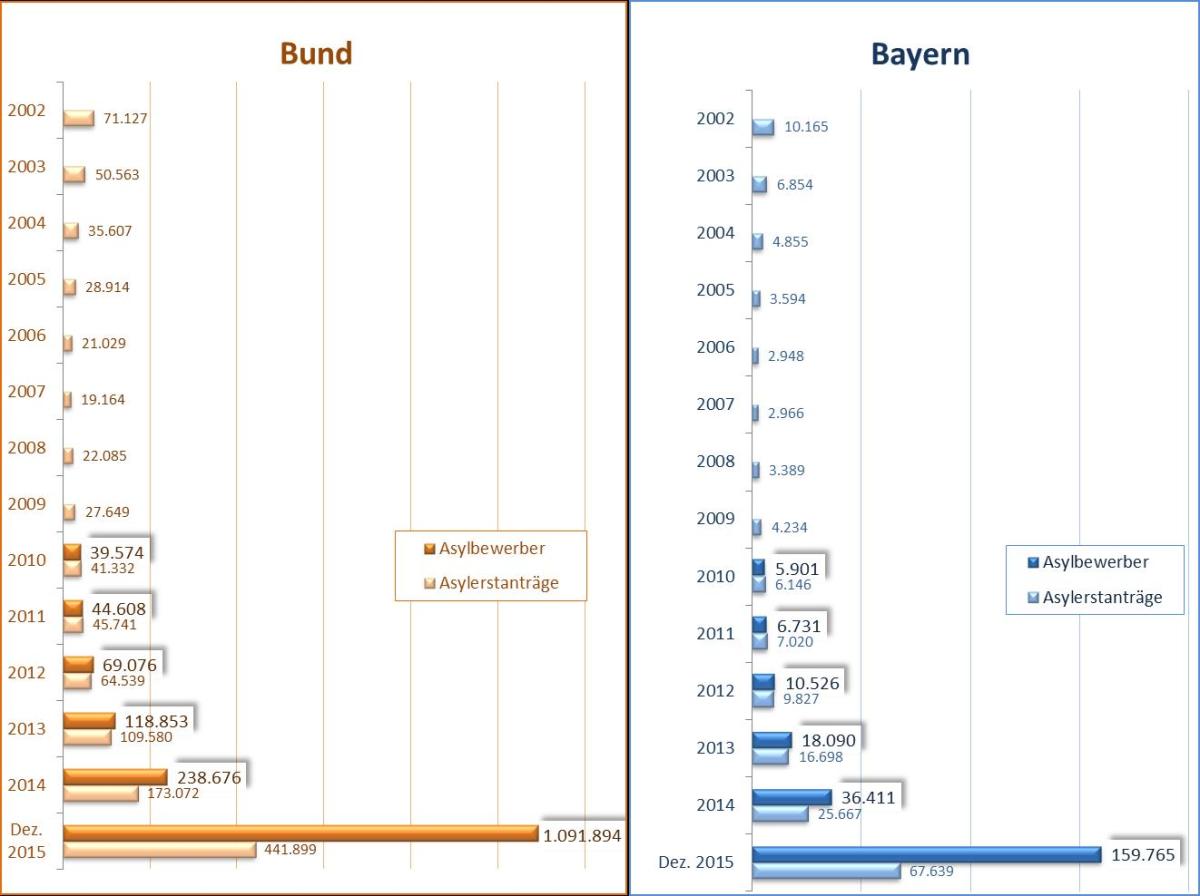English/Deutsch Munich, 28 April
650 newly arriving people per week in a city of 1,52m inhabitants – such was the situation in Munich only three months ago when refugee numbers peaked in Germany and Bavaria last year (see graph below).
Since Austria and other countries along the Western Balkan route effectively closed their borders to people without visas in February, Munich, as the destination for many of them, felt the numbers drop significantly.
As an interview with the Social and Housing Unit of the commune revealed, only 150 refugees per week currently reach the city. However, this only means that the situation in the city’s first reception centres – where asylum applicants stay for four to six weeks – has eased a bit. Since the Social and Housing Unit is also in charge of providing adequate accommodation for recognized refugees, one of its employees remarked that the coming two years will be difficult given the city’s over-heated housing market.
“The massive wave of legal recognitions is not yet there.”
The expected average recognition rate will be around 40% for all asylum applicants (of course, dependent on their nationality, individual history etc.), I was told. In the light of the nationality of asylum seekers in Munich (e.g. 31,5% Afghanistan, 30,4% Syria), the city will look at a similar rate of asylum seekers staying.
“It is essential for asylum application procedures to be handled much faster” one official remarked. This would not only help the city with its tasks, but more importantly end the often months- if not year-long “state of uncertainty” applicants are kept in. As underlined by the official, such a state has detrimental effects on asylum applicants’ chances and motivation of integration into society.
Another lesson I drew from this conversation (I have been asked about this): Obviously, there still are people on their way to Germany, despite Idomeni, despite closed borders.

650 Asylbewerber_innen, die pro Woche in einer Stadt mit 1,5 Mio. Einwohnern ankommen – so war die Situation in München vor nur drei Monaten, als die Anzahl der neu ankommenden Flüchtlinge in Deutschland und Bayern ihren Höhepunkt erreichte (siehe Graph oben).
Seitdem Österreich und andere Länder entlang der Westbalkanroute ihre Grenzen tatsächlich im Februar für Menschen ohne gültiges Visum geschlossen haben, hat auch München als Hauptziel vieler einen starken Rückgang der Zahlen erlebt.
In einem Gespräch mit dem kommunalen Sozialreferat erfuhr ich, dass aktuell nur noch rund 150 Asylsuchende pro Woche neu in die Stadt kommen – zugeteilt von der Landesregierung Oberbayern. Das bedeutet jedoch nur, dass sich die Belegungslage in den Erstaufnahmezentren, wo Asylsuchende vier bis sechs Wochen verbringen, entspannt. Da das Sozialreferat ebenfalls für die angemessene Unterbringung anerkannter Flüchtlinge zuständig ist, führte ein Mitarbeiter aus, dass die nächsten zwei Jahre im Angesicht eines angespannten Wohnungsmarktes sehr schwierig werden.
„Die große Anerkennungswelle ist noch nicht da.“
Die ab Jahresmitte erwartete Anerkennungsrate des Bundesamtes für Migration und Flüchtlinge liegt aktuell bei 40% aller Asylgesuche (natürlich abhängig von der Nationalität, dem individuellen Schicksal etc.). Die Zusammensetzung der Asylsuchenden in München ähnelt der in ganz Deutschland (bspw. 31,5% aus Afghanistan, 30,4% aus Syrien). Somit rechnet auch die Stadt mit einer Anerkennungsquote von 40% und dementsprechenden Unterbringungszahlen.
„Es ist wichtig, dass die Asylverfahren rascher durchgeführt werden“ merkte mein Gesprächspartner an. Das würde nicht nur der Kommune bei ihren Aufgaben der Unterbringung helfen, sondern besonders den oftmals monate- oder jahrelang andauernden „Schwebezustand“ der Antragssteller_innen beenden. Dieser wirke sich negativ auf ihre Möglichkeiten und die Motivation zur Integration aus.
Eine weitere Lektion dieser Unterhaltung (ich wurde schon danach gefragt): Ganz offensichtlich sind immer noch Menschen auf der Route unterwegs, um nach Deutschland zu gelangen – trotz Idomeni, trotz geschlossener Grenzen.
Weitere detaillierte Informationen zur Situation von Asylbewerber_innen und Flüchtlingen gibt es auf der Homepage des Sozialreferates der Stadt.
_____
